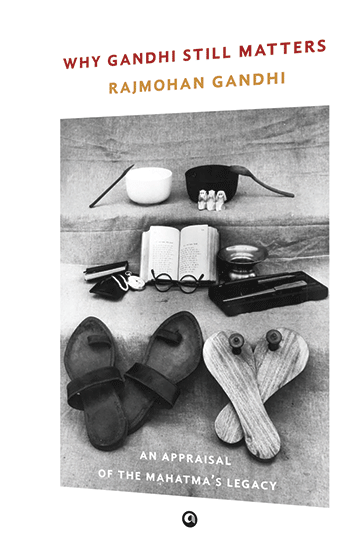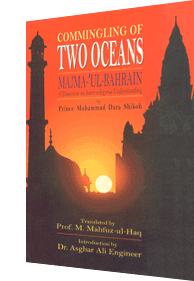Why Gandhi Still Matters, Rajmohan Gandhi, Aleph Book; Rs.499, Pages 200
 The political appropriation of Mahatma Gandhi’s legacy has been going on for decades. Now the trend has spread to unlikely quarters. Gandhi peers at us from posters, sharing space with his ideological opponents. Even personal effects like his spectacles, have been used as logos in government propaganda. Commercialisation has been a parallel process, initially for marketing products purportedly of cottage industries, and then for a whole range of other things. The powers that be appreciate the brand value of the name Gandhi.
The political appropriation of Mahatma Gandhi’s legacy has been going on for decades. Now the trend has spread to unlikely quarters. Gandhi peers at us from posters, sharing space with his ideological opponents. Even personal effects like his spectacles, have been used as logos in government propaganda. Commercialisation has been a parallel process, initially for marketing products purportedly of cottage industries, and then for a whole range of other things. The powers that be appreciate the brand value of the name Gandhi.
In this context, Prof. Rajmohan Gandhi’s latest book is welcome for it brings a breath of fresh air into cobwebbed corners of sarkari daftars and glittering platforms where Gandhi brands are appropriated or generated by professional marketing managers. This little book is the revised text of lectures Rajmohan Gandhi delivered at Michigan State University in the autumn of 2016. The author has added to that in the last chapter an insightful review of the long term significance of Hind Swaraj, “the only theoretical work Gandhi ever wrote”.
Unlike political dynasts and their worshippers, Rajmohan Gandhi perceives “no case for identifying Gandhi’s descendants as a major part of his legacy”. However, the personal memories of the author impart to the narrative a spin that is all his own.
Although a conventional narrative of Gandhi’s life does not seem to be on Rajmohan Gandhi’s agenda in this work, chapters three to five and chapter eight offer an outline, while some other chapters focus on particular issues, e.g, casteism and Ambedkar, Gandhi’s relationship with Winston Churchill, and Gandhi’s concept of ahimsa. Rajmohan Gandhi enriches his account with personal reminiscences of some of Gandhi’s famous followers, Abdul Ghaffar Khan, Martin Luther King, Nelson Mandela, the Dalai Lama and Aung San Suu Kyi. The author’s own memories of encounters with them bring these figures of history to life. The last chapter serves as Rajmohan’s own evaluation of Gandhi’s enduring contribution in terms of ideas.
Thankfully, Rajmohan has an eye for the significant detail. “In different corners of India, from posters stuck to a tree trunk maybe, or to a lamp post, wall, or billboard, a Gandhi wearing spectacles under a bald head often looks at Indians, usually next to a text which may read, ‘Let is make India clean’, or a call of that sort. For me, the eye-glasses are a reminder of Gandhi the reader, writer and independent thinker.”
The implicit message one gets in this brief review of Gandhi’s ideas and his life is that the Mahatma stood alone, not only in 1947, but at many critical points in his life and the nation’s history. His individuality was evident in the very first political tract he wrote, Hind Swaraj. Rajmohan Gandhi recognises that work as Gandhi’s major theoretical pronouncement and proposes that it contains four major themes: ‘the Empire’ signifying political domination and racial inequality, non-violence as a creed, the practice of satyagraha, and the worth of individuals as a value. Among these four themes he prioritises the first as dominant in the tract. In his view that book is “a challenge above all to Empire, rather than to modernity. If modernity is assailed in Hind Swaraj, that is because modernity is a weapon of Empire, in fact Empire’s most seductive weapon...”
It may be argued that Rajmohan Gandhi might have considered a different reading of Hind Swaraj which situates that work mainly in the domain of a cultural and civilisational discourse, rather than conventional anti-imperialist thought trends. Let us recall Mahatma Gandhi’s own comment in 1910 which makes it amply clear that the political battle for independence was secondary compared to the clash of cultures in the encounter between India and Europe. Gandhi wrote in his journal Indian Opinion (1910): “We saw in Hind Swaraj that it is not so much from British Rule that we have to save ourselves, as from Western civilisation.” Or consider Mahatma Gandhi’s repeated elaboration of his argument in Hind Swaraj. “It is my deliberate opinion that India is being ground down not under the English heel, but under that of modern civilisation.”
Again he writes: “It is not necessary for us to have as our goal the expulsion of the English... We can accommodate them. Only there is no room for their civilisation.” Or again, he surmises that most Indian politicians want “English rule without Englishmen”, that is, they would like to make India English. ‘This is not the Swaraj that I want,” he said.
As distinct from that approach, arguably, Hind Swaraj may be seen not so much a political tract, but as a cultural thesis. “I am not so much concerned about the stability of the Empire as I am about that of the ancient civilization of India...” he wrote thus in his newspaper on the publication of Hind Swaraj in 1910. Towards the end of his life he reiterates that position, in his exchanges with Jawaharlal Nehru in 1945. “I work for a civilisation”, he wrote — “a civilisation that would be different from the western or modern civilisation”. He came to recognise his isolation in pursuit of the civilisation he had imagined.
Today, many aspects of Gandhi’s thoughts on civilisation acquire a new meaning. And it has been argued by an observer that perhaps the civilisational discourse in Hind Swaraj has greater relevance today. His rejection of competition in the market, the basis of capitalist society, demands our attention today when the market culture has overwhelmed and virtually obliterated the social-welfare philosophy and agenda of action in most countries. His critique of unbridled elaboration of industrial technology calls for our attention at a time when technology threatens the ecological balance in nature and global environment. His opposition to consumerism as an end in itself appeals to many people in high consumption cultures — people who may be a minority, but a significant minority.
His community-based approach pointing to the worth of the individual and hence decentralised participatory self-government outside of the state machinery, has raised echoes in the minds of those who organise non-government communitarian initiatives with a social purpose. And finally, his contraposition of different paradigms of civilisation seems more urgently relevant when there is taking place in our times the homogenisation of the culture of the entire world on ‘the North American pattern’.
The title of Rajmohan Gandhi’s book, asking why Mahatma Gandhi still matters, appears to raise a redundant question, because the Mahatma obviously does matter. In the very beginning of this book it is acknowledged that “from both sides of bitter divides, politicians continue to invoke Gandhi. Prime Minister Narendra Modi does so all the time even as opponents charge Modi with driving nails into Gandhi’s age-old coffin”.
Rajmohan raises issues that one cannot dodge — the contrapositions, or ideational conflicts between Gandhism as one may see it in his writings and his life and work on the one hand, and on the other the shadow of Gandhi appropriated by a section of the contemporary political class for their own ends. In focusing our thoughts on these contrapositions and in raising questions about the legatees who make false claims to Mahatma Gandhi’s legacy, this book by Rajmohan Gandhi makes a lasting contribution.
Sabyasachi Bhattacharya (The Book Review, July 2017)
Profound message
Majma ul-Bahrain: Commingling of Two Oceans, Dara Shikoh, Hope India Publications; Rs.250, Pages 176
 Sufism or Islamic mysticism provides rich resources for developing theologies of interfaith and inter-community understanding, dialogue and solidarity — an urgent necessity in today’s strife-torn world.
Sufism or Islamic mysticism provides rich resources for developing theologies of interfaith and inter-community understanding, dialogue and solidarity — an urgent necessity in today’s strife-torn world.
In this connection, the literary works of Indian Sufis are particularly significant because they lived and wrote in a multi-religious context, addressing and attracting people of different faiths — Muslims, Hindus and others. Some of them developed understandings of Islam and other faiths that crossed and went beyond narrowly-constructed religious and communal boundaries, defying the empty and soulless ritualism that divided people.
Among the best-known treatises of this genre is Majma ul-Bahrain (Commingling of two oceans) by Muhammad Dara Shikoh, eldest son of Mughal Emperor Shah Jahan and heir apparent. The erudite philosopher prince was favoured as a successor by his father but was defeated and later killed by his younger brother, Aurangzeb, in a bitter struggle for the imperial throne. The ‘two oceans’ referred to in the title denote the commonalities and shared traditions of Islamic Sufism on the one hand, and Vedantic philosophy as enunciated in the Upanishadic texts of the Hindu tradition, on the other.
As the title denotes, Dara posits that, essentially, the two are the same. This being his central perception, he developed an innovative approach to interfaith and inter-community relations, which can provide inspiring insights for similar efforts in our own turbulent times of communal bigotry.
Majma ul-Bahrain is best understood in the context of Dara’s own life. Like many Mughal princes, Dara’s early education was entrusted to Muslim scholars, who taught him the Quran, Persian poetry and other subjects. In his youth, Dara interacted with several Muslim and Hindu mystics, some of whom exercised a profound influence on his thinking.
Among the most noted was Miyan Mir Sahib, a Qadri Sufi of Lahore, whose disciple he later became, and who is best remembered for laying the foundation stone of the Harmandir Sahib (also known as Golden Temple) at Amritsar on the invitation of Guru Arjan Dev Sahib, the fifth Sikh Guru.
Dara’s pluralist approach and extensive discussions with Muslim and Hindu theologians led him to explore what both systems had in common. He set about learning Sanskrit, and with the help of pandits from Benaras, translated the Upanishads into Persian, which was later followed by his Persian renderings of the Gita and Yoga Vasishta. Throughout this endeavour, his fundamental objective was the quest for discovering the universal truth of the Unity and Oneness of God.
In his Persian translation of the Upanishads, the Sirr-i-Akbar (‘The Great Secret’) he writes: “And whereas I was impressed with a longing to behold the Gnostic doctrines of every sect and to hear their lofty expressions of monotheism and had cast my eyes upon many theological books and had been a follower thereof for many years, my passion for beholding the Unity (of God), which is a boundless ocean, increased every moment. Thereafter, I began to ponder as to why the discussion of monotheism is so conspicuous in India and why the Indian mystics and theologians of ancient India do not disavow the Unity of God, nor do they find any fault with the Unitarians.”
Dara Shikoh’s writings fall into two broad categories. The first comprise books on Islamic Sufism and Muslim saints, and the other on Hindu religious beliefs. In Majma ul-Bahrain, which he completed when he was 42 years of age, Dara makes a pioneering attempt to build on the similarities between Islam and the Vedanta. He describes this treatise as “a collection of the truth and wisdom of two Truth-knowing groups”. Some sections of the book are technical, focusing on Vedantic and Sufi terms and their close similarities.
The all-encompassing message of the book is summed up in Dara’s own words: “Mysticism is equality”. And that simple but profound message is as meaningful today as it was when Dara enunciated it in the 17th century.
Roshan Shah